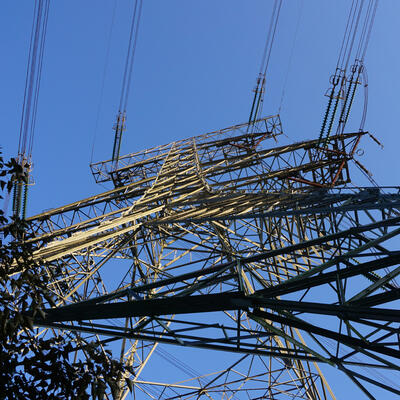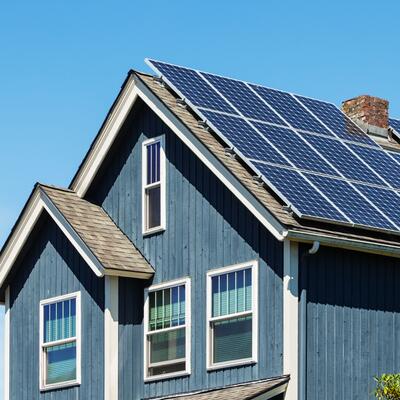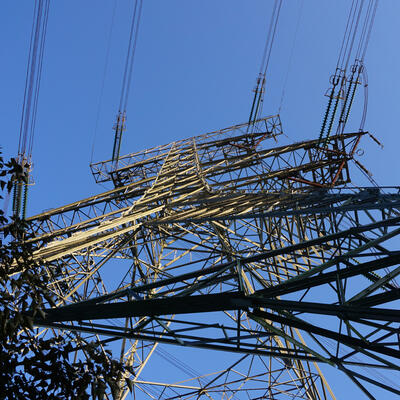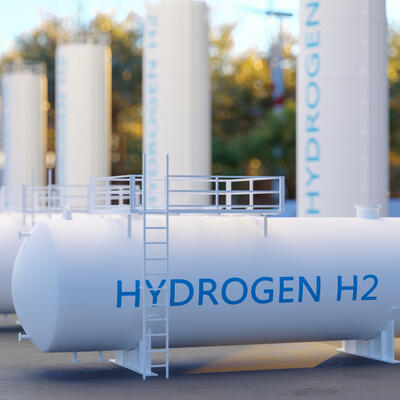
Turning Down the Heat: Decarbonizing Cement and Steel
Guests

John Fernández

Chathurika Gamage

Radhika Lalit
Summary
Along with aviation, the construction industry is one of the hardest to decarbonize sectors in the global economy. Cement and steel production together are responsible for about 15% of global CO2 emissions. But look around our modern world and it’s hard to imagine doing without these materials. Radhika Lalit, Chief Strategy Officer at the energy think tank RMI, says the use of cement is not even unique to the modern world:
“You're looking at cement that was developed 12,000 years ago in some shape or form. We had cement that had built the Greece and the Roman Empire, subsequently in England someone came up with Portland cement which is the most important cement that you use right now. But it is all pervasive and…one of the most consumed materials in the world after water.”
It takes a huge amount of heat to make cement, and that is the primary reason its production causesr 7% to 8% of global greenhouse gas emissions. If cement production were a country, it would rank third in such emissions, behind China and the United States.
There are more environmentally friendly ways to make cement, specifically alternative fuels that can also achieve the high temperatures needed for production. Some countries are already using them. Lalit says, “Europe from 2005 to 2019 the average share of heat from alternative fuels increased from just 16% to 50%. And one particular country kind of jumps up, which is Poland where the alternative fuels increased from 14% in 2005 to 70% in 2019, which really means several plants in Europe and specifically Poland have achieved really 90% of heat substitution from alternative fuels.”
Steel is surprisingly recyclable; in fact about 70% of the steel used in the US is recycled. But we can’t use recycled steel for every application. To make primary steel, one needs high heat to reduce the iron ore into iron. That process is the reason why steel is also responsible for 7% to 8% of global greenhouse gas emissions. Chathu Gamage, Manager of Climate Aligned Industries at the energy think tank RMI, explains that when cooked coal - or coke - is used to reduce iron ore into iron, that chemical process itself emits even more CO2:
“That's really due to the coke used or coke is also referred to as, you know, cooked coal. And that’s used mainly for high heat purposes within the blast furnace as well as a reduction agent. So, the main ingredient in steel is iron and to get that iron we need to first reduce the actual molecule which is iron ore extract that oxygen off. So, you’re left with iron but you also then you know because the carbon binds to the oxygen you get CO2. And so, that process will need high energy sources and a reduction enabler.”
But Gamage highlights one lower-emission technology – Direct Reduced Iron, or DRI – that already produces about 10% of global steel, using natural gas instead of coal. ”Just using natural gas instead of coal, emits about 50% less per ton of steel.” Another lower-emitting technique relies on so-called green hydrogen, which is produced by using renewable electricity to split water (H20) into hydrogen and oxygen.. When the hydrogen is burned to produce the necessary heat, it recombines with oxygen from the air, and the only emission is water vapor. “So, we would use that the same way that you would with natural gas in a DRI to produce green steel.”
John Fernández, Professor of Architecture at MIT, says that many builders are also looking to replace carbon-intensive materials like cement and steel with engineered wood products, often referred to as mass timber. “About half of the dry weight of wood is carbon. So you've got two major elements in reducing carbon emissions when you're using wood of any kind and mass timber. Certainly one is that you're sequestering that carbon in half the dry weight. The second is that you're replacing steel or, or concrete. So the amount of carbon that you're sequestering is just half of the equation. The other half of the equation is that you're displacing the cement or the steel that you would be using otherwise.”
Related Links:
Embodied Carbon in Construction Calculator (EC3)
Full Transcript
Greg Dalton: This is Climate One. I’m Greg Dalton. Along with aviation, the construction industry is one of the hardest sectors to decarbonize in the global economy. Carbon-negative cement has been talked about for years, and innovations in steel production show promise as well, but is either technology ready for primetime? And what about replacing these materials with engineered wood, which could also store carbon for decades?
John Fernández is Professor of Architecture at MIT, and Director of MIT’s Environmental Solutions Initiative. I asked him what makes construction materials such a challenging problem.
John Fernández: Cement, steel, aviation, shipping. Those are some of the most intractable areas for reducing carbon emissions. Partly because these are industrial processes that actually don't have a good alternative today to produce at scale and economically the materials that are used for the primary materials used for construction. So this is the, the wicked problem. These, these materials in construction. When you're talking about carbon emissions in the construction industry, you have to talk about steel and concrete to begin with. So for example, every ton of steel produces about 1.85 tons of carbon dioxide. Now that's coming in steel, primarily from the high temperatures needed to process steel. It comes to some extent from extraction activities as well, but, but the high temperatures in processing are where that's coming from. For concrete, it's slightly different. So for every ton of concrete, you're emitting about a half to maybe 0.6, tons of CO2 for every ton of concrete. And it's coming from two different places. and the two places are the actual chemical process of producing cement itself and making that clinker. That's the word for the actual binding material in cement actually is a CO2 producing chemical process. So actually directly from the chemical process, you're producing CO2. But then also just like steel, you're doing that in a very high temperature environment. You've got 2,600 degrees Fahrenheit. And of course, to produce as high temperatures, your burning energy, your, and, and, and there's a lot of emissions coming from, you know, primarily the, the combustion of, of fossil fuels to do that.
Greg Dalton: Right. And a lot of consumer-facing brands are doing things to address their supply chain, the inputs, where they get their water, where they get their woods, you know, forest stewardship council, those sorts of things. Uh, but here, what buildings, uh, you know, there's not isn't consumer, consumer branded buildings. Where's the pull, either the market pull or the policy push to get cleaner steel and cleaner concrete?
John Fernández: Yeah, well, so there is certainly both there's there's the market pull. So it's very clear that the market is valuing green buildings and, and this is not new. Um, in the United States, I was involved in the beginnings of the United States green building council and in the early days, it was just a few people going to their conferences and the market was the obstacle because you actually couldn't produce a net zero energy building. Amazingly the market really turned around and is now developing now is very well positioned to supply the devices, the materials, the assemblies needed for high performance buildings and even net zero energy buildings. So there's definitely a market pull and the market pull goes all the way back to the finance and the tenants. And we see in buildings, in fact, here in Boston, there's a building. That's a passive house rated building. It's a commercial office, it's actually gonna be the largest commercial office building passive house in the, in the, in the world. And a passive house refers to the idea that a system of high performance windows,natural ventilation, super insulated exterior walls and good thermal mass. That means enough mass in the building to retain heat. These things come together as a system and substantially reduce the energy consumption of the building to about 65 to 85%. And one of the very nicest things about the passive house story is that the source of heat is the sun, but it's also people and devices like computers. By coming to work, you're actually lending your body heat to heat the space, which gets circulated throughout the space and helps to actually create a comfortable interior temperature. I know. Because I've been involved in that building, that one of the major tenants signed a lease specifically because it's a passive house because they want their employees to feel good about coming to work. And these days getting people to, to go to the office is a, is, is a major challenge. So, so there's a, so there's definitely a market pull, but the push has to be there too. And the push is happening at the international level, beginning with the international level, with the, the Paris agreement. But then national determined contributions for carbon emission reductions. The built environment is, has been for decades and remains the low hanging fruit. The smartest dollar you can spend - primarily in efficiency in reducing carbon emissions to meet your goals, your nationally determined goals for, for carbon reduction. So, so there is definitely a role for government push, but as we know, it's not strong enough. Construction, um, has a long way to go.The built environment needs to reduce its carbon emissions by half every decade. And carbon emissions from the build environment, generally from buildings generally is still going up. Buildings are more efficient, but there are more of them every year.
Greg Dalton: Elsewhere in the program. We'll be talking specifically about reducing the carbon intensity of cement and steel. For those who don't know what is mass timber and how does this carbon math pencil out?
John Fernández: Yeah. So mass timber is an umbrella term. There are actually a number of different types of mass timber. there's, there's a glue LA. So this is a type of glue, laminated lumber, there's laminated veneer lumber, which is LVLs. Then there's the cross laminated timber cross laminated timber is an interesting material because you. Orthogonally crossing layers of timber. And we're talking when, when layers of lumber, I should say. So we're talking two by four sized lumber and they're stacked together. They're glued. And then the next layer is orthogonal to that. It's basically a very large scale plywood, right? And the fact that you have orthogonal layers means that it. Very dimensionally, stable and strength to weight ratio is very, very good. but all of these types of wood fall under an engineered wood label. So mass timber buildings are primarily engineered wood buildings, but there is one other type which is timber buildings. So we know like, you know, just, uh, the kind of post and beam timber building. Where the members are made, not out of engineered wood, but out of single trees. Right? So you think about, you know, a ski lodge that's made out of post and beam, members of wood that's, that's different from engineered woods.
Greg Dalton: And how does the carbon math of that pencil that mass timber pencil out is, you know, you're saying it's almost that it's as strong as steel, is it better than steel in terms of carbon?
John Fernández: Well it's so in terms of steel, so the dry weight of wood,Of any piece of wood, about half of the dry weight of wood is carbon. So you've got two. Major elements in reducing carbon emissions when you're using wood of any kind and mass timber. Certainly one is that you're sequestering that carbon in half the dry weight. The second is that you're replacing steel or, or concrete. So you're so, so the amount of carbon that you're sequestering is just half of the equation. The other half of the equation is that you're displacing the cement or the steel that you would be using otherwise.
Greg Dalton: So I hear that, you know, wood, uh, is embodied carbon. You said about half of the weight of dry wood is, is carbon that's versus steel, which creates, a lot of carbon emissions because of the high temperatures in making it yet so that sounds like, oh, okay. Wood better than steel. But with deforestation being such a driver of climate change, why would we wanna, you know, increase the demand for forest products and drive deforestation?
John Fernández: Yeah, I mean, so that's, that's an excellent point. The fact is that. That's the other side of the consideration. That's really, really important. The sourcing of the wood. So there's a global perspective, which is that in the developed north and certainly in north America, forest cover is stable and has even increased over the last few decades. So, so the, so the, the forest forest cover itself is relatively, um, there's not, there's, there's not a threat to deforestation in the United States and in Europe.
Greg Dalton: Although I, if I could jump in professor, you know, the, the wildfires in the American absolutely have taken out millions of acres a year, so that math, you
John Fernández: Absolutely. And, and part of the mass timber story is that the industry is keen to harvest a lot of that dry and dead wood partly to reduce the amount of fuel in national forests. Certainly there has been a lot of forest lost by way of fires, but again, over the several decades over the several past decades, forest covers is relatively stable. There's not a, there's not a worry of vast deforestation by way of industrial processes. That's a completely different story in the developed south. So in the global south deforestation absolutely is an incredibly important topic. So, a good way of thinking about this is that, um, The sourcing in the developed north has to be as local as possible. And I think one, some of the best demonstrations of this, there's a building in Norway. it's a, it's now the world's tallest mass timber building at 18 stories and the source wood for that building and its mass timber columns and beams are sourced locally from, from Norway in a managed forest. And that's really the way to do it.
Greg Dalton: That raises the equity question. The global north has a long history of, you know, extracting, you know? Um, so does that mean that those, you know, Some of those economies would be, um, negatively impacted if they no longer were exporting products to the global north, if everything was sourced locally, wouldn't that hurt
John Fernández: So well, so the, the next step though on the international trade of wood is managing the sources. So it's certainly, I'm not, I'm not advocating for no international trade in wood. I'm advocating for managed sources, managed forest that can provide the materials for, for, for engineered wood. I am also just wanna make sure that we cover the co-benefit of, um, reducing biodiversity loss. So targeting small caliber trees, small dimension trees is important doing that in a managed way, and that can even be done in biodiversity hotspots. That those small diameter trees can be milled into engineered wood. That's one of the benefits of engineered wood. You take those small calibers and you, you, uh, process them and then you,glue them all together into a high performance component wood component. That's a completely viable, sustainable strategy and you can not affect biodiversity in that case. And that can be an internationally traded product there. No question about that. I think the key is really not only the establishment of robust managed resources, but as with all things, enforcement, continued enforcement and monitoring such that the resources is sustainably harvested.
Greg Dalton: You say that urban populations will double in the next 30 years and about 90% of that growth will be in developing countries. You know, the urbanization of China is one of the biggest drivers for carbon math, how China urbanizes, whether that's built around a single family car, you know, the buildings and construction, you're the professor of urbanization. You know, you know what it's gonna take for cities in those countries to implement the kinds of materials we're talking about, especially if they are novel and perhaps more expensive.
John Fernández: So in the, in Africa, in south Asia, Southeast, There is a real potential for using cellulose materials and, prime candidate there is, is bamboo and other engineered cellulose products. The real benefit there in a developing region is not only the avoided carbon from the reduced use in concrete and steel, but also the employment opportunities. So production of novel employment opportunities by way of the processing of these materials and, and, and doing it at various scales at a sort of, small cottage scale, to the industrial scale. So there's good potential in developing regions of the world.
Greg Dalton: And, how close could mass timber come to replacing the more carbon intensive materials we often hear about this is a emerging category, you know, how much of an impact could it make both in terms of direct carbon sequestration and an avoided emissions for other materials?
John Fernández: Yeah, so honestly, It's going to be a very small portion of the, certainly of the sequestration or the storage of carbon. It’s important to note that what we need today are solutions that are this decade. So we need carbon solutions this decade, next decade. But really we, we really need to be moved very quickly. Trees store carbon, but it takes them a long time to store carbon and so on the one hand, it's a long term carbon storage solution. So ideally one could imagine a future decades from now where there are many, many mass timber buildings. And there is a lot of stored carbon in terms of the amount of stored carbon it's. It's not gonna be anywhere near, um, 1%. It's gonna be much less than that. 1% globally. However, as you said, as much of the replacement of steel and concrete and cement that can happen by way of using mass timber buildings, that's really where the low hanging fruit that's where the greatest returns will be. So taking a dent off of the 8% of global emissions that are related just to cement production you know, if one were to take a percent or two away from that, because you're replacing it with alternative materials and buildings that that's a major, major savings. So it's really the emissions avoidance by replacing concrete and steel, to some extent.
Greg Dalton: John Fernández is professor of architecture at MIT and director of MIT's environmental solutions initiative, professor, thanks for coming on climate one today and explaining the built environment.
John Fernández: Thanks for having me.
Greg Dalton: You’re listening to a Climate One conversation about reducing emissions in two of the most hard-to-decarbonize industries: cement and steel. Our podcasts typically contain extra content beyond what’s heard on the radio. If you missed a previous episode, or want to hear more of Climate One’s empowering conversations, subscribe to our podcast wherever you get your pods. Coming up, the potential for making greener cement.
Radhika Lalit: At this point there is very low levels of alternative fuels or non fossil fuel-based inputs that we use to heat the kiln at those very, very high temperatures. But in Europe actually you have a history of using higher degrees of alternative fuels. From 2005 to 2019 the average share of heat from alternative fuels increased from just 16% to 50%.
Greg Dalton: That’s up next, when Climate One continues.
Greg Dalton: This is Climate One. I’m Greg Dalton, and we’re talking about how to reduce the amount of carbon dioxide emitted in the production of cement and steel.
Cement is the second-most used commodity in the world, after water. It’s everywhere and it’s responsible for about 8% of the world’s greenhouse gas emissions. That’s rising as the world becomes more urban. When I look at sidewalks and highways, I see all that embodied carbon. Radhika Lalit is Chief Strategy Officer of the Mission Possible Partnership at the energy think tank RMI. When she looks at cement, she sees something more.
Radhika Lalit: It's hard not to be impressed by the human ingenuity around the substance that’s primarily just a binder but that has something to do with some of the most beautiful marvels of built environment and infrastructure around us. And that potentially underpins development in our civilization.
Greg Dalton: I often ask people about their climate awakening moments. And I’ve never talked to someone before who went to a cement plant and thought of it as beautiful and amazing. So, this is a first for sure. And cement is a thing that you notice everywhere I think sometimes people think of it as kind of, I don’t know boring, take it for granted. How ubiquitous is cement in the built environment?
Radhika Lalit: It's everywhere around us. And, you know, the history that I'm most fascinated about, right, like this is not something that was just developed right now. You're looking at cement that was developed 12,000 years ago in some shape or form. We had cement that had built the Greece and the Roman Empire, you know, subsequently in England someone came up with Portland cement which is the most important cement that you use right now. But it is all pervasive and like I said one of the most consumed materials in the world after water. So, you see it in the built environment, you see it in construction of ports, all infrastructure around you, roads. So, everywhere you see, you will find cement and cementitious materials.
Greg Dalton: I had no idea it has such a long history. If cement were a country where would it rank on greenhouse gas emissions?
Radhika Lalit: Yeah well, it would be the third largest emitter of greenhouse gasses only behind China and the United States. You're looking at around 7% to 8% of global emissions per year which is quite substantial. And more than half of these emissions are actually coming from China which actually is the largest producer as well. And then the distant second is India which makes up for like 9% of global emissions with regards to cement and concrete. And yeah, it’s too big to ignore.
Greg Dalton: And it’s everywhere. I have climate eyes; everywhere I look I see embedded energy in every product that I look around like oh there’s energy and water to make that. When you look at cement everywhere, how does it make you feel? Do you see like, oh, this is so big do you feel dread or opportunity?
Radhika Lalit: Yeah. Like I said, I’m fascinated by this, this one material that is kind of taking the world in a different place. I think, you know, it is the bedrock of economic prosperity. And I definitely think that we've been using more and more of it so I have mixed thoughts on that. But, you know, just let me take you to the journey of how much production has happened. So, roughly the production since 1950s has increased by more than 30 times. That's roughly 4 times since 1990s. And China alone has used more cement between 2011 and 2013 than the entire United States did in the entire 20th century, which has led to its development.
Greg Dalton: Let me get that. China in a couple of years used as much cement as the United States did in a whole 20th century. Wow.
Radhika Lalit: Yeah. It is wow, right? That’s what fascinates me. And it's only going to grow like of course China has peaked its consumption almost and the future growth and construction industry is gonna dictate where more cement and concrete production and consumption is going to happen. But largely, South Asia, Southeast Asia, sub-Saharan Africa are going to be those markets that we will see this consumption taking place in. And it’s gonna be rapid and it is driven by urbanization, population growth, economic development, yeah. And you're looking at roughly 5 billion metric tons per year within the next three decades.
Greg Dalton: Can you walk us through how cement is traditionally made and why it's so carbon intensive?
Radhika Lalit: Yeah, absolutely. So, traditionally the Portland cement is made by calcinating limestone And you do that in a rotating kiln so you heat up that temperature you kind of put the crushed limestone in it and you produce something called clinker which is the binding agent in cement, right. The clinker is then ground with sand and gravel to create the cement. This chemical reaction is the very basic reaction that we’ve been doing since 1845. The chemical reaction itself is around 60% to 65% of the emissions. And this process is called calcination essentially, you break down limestone to produce at very high temperatures. And what it decomposes into is lime and CO2. So, the chemical reaction itself as you can see kind of releases CO2 and that's the majority of the emissions. The 35% to 40% of the emissions then come from really burning coal or fossil fuels or natural gas to really achieve these high temperatures this kiln.
Greg Dalton: So, two big levers to reduce emissions: high heat and the chemical process itself. Let’s start with the heat and the energy input requirements. What can be done there, you know, basically fuel substitution moving away from coal to something else?
Radhika Lalit: That's exactly right. I think you know at this point there is very low levels of alternative fuels or non fossil fuel-based inputs that we use to heat the kiln at those very, very high temperatures. And that is the case in most economies, but primarily the big ones, US, India, China you have very high amounts of pet coal, natural gas that is being used to sort of heat the kiln at very high temperatures. But in Europe actually you have a history of sort of using higher degrees of alternative fuels. So, an example of that is roughly in Europe from 2005 to 2019 the average share of heat from alternative fuels increased from just 16% to 50%. And one particular country kind of jumps up, which is Poland where the alternative fuels increased from 14% in 2005 to 70% in 2019, which really means several plants in Europe and specifically Poland have achieved really 90% of heat substitution from alternative fuels and that is thanks to very good regulatory environment, social acceptance, and a lot of investment support.
Greg Dalton: That's a big deal because Poland is a coal country. The second big lever, changing the chemical process used to produce cement. The chemical reaction that produces most of the CO2 from this industry. So, what's the state of technological innovation there for greener cement?
Radhika Lalit: Yeah. There are several levers to sort of curb carbon emissions within the 60% of the chemical reaction itself. One is, of course, to use less which is material efficiency essentially. And what that is is essentially I like to break it down in 3Rs. One is you reduce the amount of clinker in cement by substituting it with alternatives. So, what that is is, you know, in our common language here we call it supplementary cementitious materials. And what that really is is fly ash, slag and other materials that help substitute the amount of clinker in cement itself. The second R of this is really readjusting the way clinker is made and that is by reducing the amount of limestone in feedstocks or modifying the calcination process itself. So, there is some innovation that is happening on that. The third piece is really reformulating the cement chemistries by developing new binders, normal materials and low carbon processes. So, there is definitely movement happening in the innovations piece across all the 3Rs which is specific around use less or material efficiency. And then the last and the most important lever which actually you know, some say could contribute as much as like 40% to the decarbonization story of the sector is really carbon capture utilization and sequestration/storage technologies.
Greg Dalton: So, lots of opportunities there to do that. Of course, we’ve been hearing about clean or green cement for some time, but a lot of these promises don't really scale. We hear about something that’s like, oh cool, this could have a huge thing and then they fade. So, what's the prospect for scaling cleaner cement?
Radhika Lalit: I was thinking there’s a lot of potential but there are also several barriers. I think the first barrier is really around the price premium. This is called a hard to abate sector because it's extremely hard to abate. And any changes in technology really do mean that this is going to be expensive. So, you know, this is an example, if we were to say today say lets you know use CCS, CCUS on a cement plant to reduce emissions --
Greg Dalton: That’s carbon capture and sequestration.
Radhika Lalit: Yes, exactly. That itself will add $100 per ton to the cost of cement. So, how do you pass on that cost to something that's highly commoditized. It's a huge barrier, price premium will always be a huge barrier. The second barrier I think that several startups need to think to is really regulatory policy and testing standards. Several of the regulated standards right now on cement and concrete tend to be quite prescriptive and we really need to move from prescriptive to more performance-based standards as a way to redefine this industry. And so, that is definitely something that is a potential barrier. I'd say that you know there is also a demand-side barrier where there isn't enough demand for something new, something different you know. There’s different users and consumers across the cement and concrete use and you have engineering companies, construction companies. All of them may or may not be willing to purchase a low carbon product. So, the demand signal needs to be stronger, which it isn't at the moment. And then I think lastly, I would say that there is a barrier around policies and incentives for decarbonization itself. If we did hypothetically have a carbon price then of course you would price these externalities or these costs into the production and therefore it would be a level playing field, but that's not the case and that's not the reality we’re dealing with. So, lack of these policies that address carbon will lead to higher costs, higher first costs and therefore there will be some concerns across the board for how do you overcome these costs and barriers. And, yeah, another one that comes to mind would be around perception. There’s a lot of perception issues around is this new cement or new concrete alternate cement or alternate concrete really have the strength as the traditional ordinary Portland cement and that is something that will always be challenged. And so, how do we overcome that perception barrier as well with data with more information out there, it’s really important.
Greg Dalton: I went through something like that personally recently where I was doing some construction work at my home in California. So, it has to have really strong footings and said to the architect and manager like I want some low-carbon cement and they kind of looked at each other like, ugh, what is that mean? Where do we get it? Is it gonna be strong enough? Who’s gonna get in trouble if it doesn't perform? And eventually they think they found some with fly ash. But thinking on a broader scale I’m thinking of some things like LEED buildings for example, you know, where there’s kind of a consumer facing where large corporations say we want LEED Gold or Platinum buildings. Does that include cement, you know, because without any kind of consumer facing you call it demand signal or pull it seems like there's not gonna be that price premium. With LEED buildings people do pay a little more for recyclable materials, all the things going on to a greener, they’re willing to pay that green premium. So, is that connected to cement or not?
Radhika Lalit: Yeah, definitely LEED standards have they talk about embodied carbon they talk about you know, and the largest embodied carbon comes from steel and concrete so the two materials. So, definitely it is part of the standards. But, you know, to your question earlier it’s like how do corporates or big procurers who are looking to buy low carbon cement and concrete today. How do they work around this problem of finding the right supplier, finding the right quantities, being able to compare likes with likes. And I think this is a real problem, and there’s a lot more progress that needs to be made and will be made over time as we start to optimize for carbon emissions rather than just cost and costs itself. But there is a tool that I think I want to make a plug for which is the EC3 tool by Building Transparency which by the way is free to register. And anyone can register homeowner or a big corporate, anyone, or government. And you know that collects EPD data, which is basically the performance data of cement and concrete. And it allows you to compare one cement and concrete vis-a-vis and other through the different parameter. So, it allows you to sort of at least there is a tool that allows you to compare like with like and sort of give you an understanding of what is the embodied carbon within each of you know the different cement blends that you will buy and how will that make a difference to your net goal.
Greg Dalton: The Buy Clean California Act just went into effect on July 1st and it puts limits on the global warming potential of certain materials, mainly steel and glass used in state building projects. Cement isn't on the initial list but could be added in the future. How much of a difference would that make?
Radhika Lalit: Yeah. So, Buy Clean originally is a great example of public procurement policies that will incentivize the producers of these materials to really you know make those investments those big investments for decarbonization. And so, like you said California doesn't have it but you have Colorado, New Jersey, New York all of them have passed legislation on cleaner concrete and the trend is that this is going to grow beyond just these states that I named. And of course, there’s Buy Clean policies at the federal level as well the Biden administration announced recently. So, this is huge, right. Public procurement is a huge lever and I say that because governments are the largest buyers of cement and concrete. It goes from 20% to like 50% and beyond of these products. And so, when such a large buyer of your material makes a demand for lower carbon product then you see change coming. And it's not just, you know, procurement doesn't only have to be public, but I'm also seeing trends around corporates coming together and saying we'd like to buy and procure low carbon concrete. And there’s a recent movement around that started by the climate group, ConcreteZero it's called, and this is where corporates are signing on to commitments to buy low carbon cement and concrete. and this is what we need, right? We need the demand side to come together. We need the finance to support at very incentivize. And then we need policies that really help further this along and this is exactly what success looks like.
Greg Dalton: And I can see that happening in rich countries where there is pressure on corporations to measure their supply chains and the inputs into their buildings and factories etc. When we've talked about cement being a commodity and the industry being focused on cost and most of the future demand growth in the developing world you said Southeast Asia and Africa. So, how can we expect them to pay a premium for greener materials when they’re just trying to get their countries out of poverty?
Radhika Lalit: It’s such an important question. And, you know, there is no easy answer. There is no one silver bullet, because like I said there are interventions that have to happen at every level where you know you literally start at the design stage and you say how do we use less materials in the first goal. And how do we use lower carbon materials when we have to use those materials and how do we reuse. And for developing economies there needs to be this trifecta of finance coming together and that could be enabled by multilaterals and, you know, other developed countries who can give concessionary finance to help spur lower embodied carbon materials, steel, cement included. And then the industry really needs to up its game and like I said they didn't have incentives earlier to optimize for carbon emissions. They were optimizing for something and that was cost. They were giving you the lowest cost product. But now they need to give you the lowest cost product at the lowest carbon.
Greg Dalton: Radhika Lalit is Chief Strategy Officer at the Mission Possible Partnership at the Rocky Mountain Institute.Thank you for making cement exciting.
Radhika Lalit: Absolutely, Greg. Thank you for having me and this has been a wonderful conversation.
Greg Dalton: You're listening to a conversation about decarbonizing cement and steel. This is Climate One. Coming up: Like cement, the production of steel requires intense heat, which accounts for the lion’s share of its carbon footprint. But that heat does not necessarily have to come from burning fossil fuels.
Chathurika Gamage: Green hydrogen, we typically refer to that as hydrogen being made by splitting water through renewable electricity with an electrolyzer. So, that green hydrogen because it's coming from a renewable electricity source the emissions are low and the byproduct just being kind of oxygen and water vapor from that.
Greg Dalton: That’s up next, when Climate One continues.
Greg Dalton: This is Climate One. I’m Greg Dalton. We’re talking about how to reduce the greenhouse gas emissions from two of the hardest-to-abate industries in the world: the production of cement and steel. Steel is surprisingly recyclable, but we can’t use recycled steel for every application. To make primary steel, one needs high heat to reduce the iron ore into iron. Chathu Gamage is Manager of Climate Aligned Industries at the energy think tank RMI. She explains that when cooked coal - or coke - is used to reduce iron ore into iron, that chemical process itself emits even more CO2.
Chathurika Gamage: the process of turning iron ore into steel actually makes up about 7 to 8% of global emissions and that iron making part is the carbon intensive. So, to dive a little bit deeper into that, that's really due to the coke used or coke is also referred to as, you know, cooked coal. And that’s used mainly for high heat purposes within the blast furnace as well as a reduction agent. So, the main ingredient in steel is iron and to get that iron we need to first reduce the actual molecule which is iron ore extract that oxygen off. So, you’re left with iron but you also then you know because the carbon binds to the oxygen you get CO2. And so, that process will need high energy sources and a reduction enabler. And those options exist and we need to kind of accelerate that a little bit further.
Greg Dalton: So, what are the pathways to perhaps changing that manufacturing process?
Chathurika Gamage: Yes. So, for starters we have a different technology that actually makes about 10% of global steel at the moment, which uses natural gas as that reductant and heating service. And that technology is called direct reduced iron or DRI for short. And just using natural gas instead of coal, you know, emits about 50% less per ton of steel. So, that technology has, you know, tried and tested; it’s out there. So, and then in terms of you know moving towards technologies that can go beyond that 50% or what we might call is deep decarbonization technologies for steel. We've got several options. Primarily sort of sitting in the buckets of green hydrogen as well as CCS.
Greg Dalton: Why don’t you define green hydrogen and carbon capture and sequestration. What are those mean?
Chathurika Gamage: Yeah sure. So, green hydrogen we typically refer to that as hydrogen being made by splitting water through renewable electricity with an electrolyzer. So, that green hydrogen because it's coming from a renewable electricity source the emissions are low and the byproduct just being kind of oxygen and water vapor from that. So, we would use that the same way that you would with natural gas in a DRI to produce green steel essentially. And there’s a few pilot plants that we can talk about that's doing great work in that region. And CCS is carbon capture and storage very similar to carbon capture that’s using power plants at the moment or refineries and exactly the same type of technology where you would place that carbon capture on top of emission source point sources along the system. And you really have to then think about storing that carbon or if you are utilizing that carbon and that will have impacts towards you know what the footprint of the steel will be.
Greg Dalton: And you mentioned a couple pilot projects producing green steel. If this technology works. Why isn't it being deployed more widely. Is it more expensive?
Chathurika Gamage: It is more expensive and so this is kind of the test in terms of when you think about technology scaling. So, we have a few plants at the moment in Sweden that are going through this multimillion sort of ton scale that we need to see in sort of steel production. Green hydrogen is still cost prohibitive or expensive today. But we see those costs going down. RMI has reported on that as well as you know external sources saying that even before 2030, we will see green hydrogen being cost competitive with the other types of ways to make hydrogen, and therefore that technology will naturally be picked up in the market because it provides emissions reductions, but it's also cost competitive.
Greg Dalton: Right. So, green hydrogen made from renewable electricity. Blue hydrogen made from fossils but the carbon emissions are captured somewhere. All of this sounds very expensive. Sweden think of as a country with a heavy government role in the economy. Where's all the money going to come from to make these technological transitions?
Chathurika Gamage: Yeah, so the money is, you know, in terms of pulling this necessary demand, especially for first movers. So, as we talked about because green hydrogen and those electrolyzers lend themselves to a learning rate similar to renewables. So, we can see once we invest in these projects early everyone will sort of reap the benefits going forward. And so, when we just focus on the money and who needs to pay for this and what support is available for these first movers, we can see necessary demand being pulled by either government support as you talked about just direct grant and fundraising. And then there’s also pulling that demand through public procurement, so governments listing that they need to purchase steel of a certain lower embodied carbon for example, and private sort of demand commitments as well.
Greg Dalton: I was a little surprised and pleased to learn how much steel is recycled in the United States and is there also an export opportunity for the US to be an exporter of recycled steel?
Chathurika Gamage: Yes, so I think the US is certainly doing a great job and it's also when you think about the lifecycle of steel a little bit. So, we have so much recycled steel because we also made so much decades ago and therefore there’s a market, when that steel comes. Steel is essentially infinitely recyclable in the sense that you know you can keep doing that. It has that physical property that allows it to be this way and it's versatile. But it can’t be used in everything. And so, that's why primary steel is also required. And to your question on could we be an exporter? I think, certainly, but when we also look at the US it also imports about 20 million tons of steel. So, it's almost building that foundational base first of do we want to not be importing and be a country that meets all of its domestic demand and then think to expand that base and almost like re-industrialize US steel to become this exporter.
Greg Dalton: So, we’re importing primary steel because we don't make it ourselves and there are certain uses for which recycled steel is not appropriate – is that what that is?
Chathurika Gamage: Yeah, that’s exactly right.
Greg Dalton: And what's driving the demand for greener steel. Is it auto companies is it companies making dishwashers and washing machines like who want to have a roll up to a brand level to say hey, this is low carbon product both in its manufacturer and its use. What's driving the demand for greener steel?
Chathurika Gamage: Yeah, so when we think about like private demand sectors that you talked about. There’s groups that are trying to coalesce so you can send a much stronger demand signal. So, places like the climate group steel zero initiatives and First Movers Coalition that are trying to aggregate this demand. So, certainly big sectors, offtake sectors like auto. So, I think they use about 12% of the global steel that’s made because about half the material in a car is steel. And so, they are pushed by not only regulators but to your point like very climate conscious consumers, and it’s almost a brand when you can sell that as a green steel product. And what we found is you know through sort of supply chain modeling is the premium that would be paid right at the end customer, so you and me buying a car. It's actually you know would be about $400 kind of per vehicle. So, the pass-through costs would not be that much. And so, we’re seeing, you know, the more high-end order makers. So, Mercedes, Volvo, BMW already doing sort of first move of contracts with the likes of HYBRIT and H2 Green Steel and some of those green steelmakers that we talked about committing to putting trucks for example, with fossil free steel on the market by you know as soon as 2025, 2026. And that's around the corner so it’s pretty promising.
Greg Dalton: You mentioned that the countries or regions best position to capitalize on a demand for zero carbon or low carbon steel are those with both plentiful iron ore and renewable resources such as wind and solar to power the production of green hydrogen. So which countries are best positioned and where does that leave the US and China?
Chathurika Gamage: Yeah, so, I think in terms of that combination. It's usually countries that might have a very small domestic production at the moment. So, we see that as you know an opportunity if they feel like taking that out. So, certainly places like Australia, which as you know, the world's biggest exporter of iron ore at the moment and certainly sun-kissed country in that sense could forward integrate. Other places that I mentioned in Brazil places in South America, South Africa and some regions in North America. And so, you know, Canada, for example, is also looking at this and that could, you know, certainly be a path way for importing into the US given that we have quite a cordial relationship in terms of steel products going back and forth through the border. Where does that leave the US and China is, you know, I'll tackle the US first. So, we talked about the US being quite different in the way that its steel assets have built-up. We have a lot more EAFs, so, ability to recycle. So, EAF mean those electric arc furnaces, 70% of US steel is made through those electric arc furnaces. But the emissions number is flipped and we have obviously more emissions coming from the primary production. And so, a chance for that to build on regions in the US, like West Texas or, you know, the central plains essentially where high wind capacity. And there are iron ore mines here right here in the US that are utilized for primary steel up north as well. And so, we see that happening, but it might change the way, where primary steel is located. And so, government support is needed to think about those existing communities, right, in the Rust Belt and how do we support those communities to either accept new green technology into that region or think about either having to move some of this production to where low-cost hydrogen can be made.
Greg Dalton: And while hydrogen is one piece you also mentioned methane gas as a substitute for coal to achieve the high temperatures needed. There's quite a debate as you know, in energy and environment circles about methane gas as a bridge fuel is it better than coal, no, you know. So, where do you come down on you said what 50% cleaner using methane gas than coal. Sounds like a good deal but other people might say, ugh, no, we shouldn't lock in more gas infrastructure because it's not what its promised to be.
Chathurika Gamage: Yeah, for sure. And also given the point that we see you know green hydrogen becoming more competitive or as cost competitive with blue hydrogen within this decade. It sort of doesn't make sense from that aspect as well. But certainly, places like Texas and Pennsylvania in the US, as well as other regions of the world that are so natural gas heavy and have all the infrastructure and everything is built out. It seems to as you say would make sense and it's a nice story. But when we think about the lifecycle emissions, methane being a highly potent global warming potential of over 84 times that of CO2, it’s very crucial that the natural gas that is supplied to make either blue hydrogen or you know this other form of steel in DRI is the lowest it can be. And that can be through, you know, getting certified natural gas for example. And so, those mechanisms exist that a buyer can be sure that every bit of the supply chain is as low emissions as possible. On the other side of the house is making sure that the actual capture on the CCS also achieves a consistent high capture rate. And so, most of the existing projects of CCS in power for example, are achieving high capture but in terms of other industry it’s, you know, really kind of falling to run 60 to 70%. And there's only one CCS commercial project for steel at the moment and that is actually in place in Abu Dhabi. That capture is being used for enhance oil recovery. And so, when you think about you know again that whole lifecycle it might not, you know, make the most sense from the environment's perspective on if true emissions were saved.
Greg Dalton: Chathu Gamage is Manager of Climate Aligned Industries at the Rocky Mountains Institute. Chathu, thanks for coming on Climate One today.
Chathurika Gamage: Thanks. Happy to be here.
Greg Dalton: On this Climate One... We’ve been talking about decarbonizing cement and steel. Climate One’s empowering conversations connect all aspects of the climate emergency. To hear more, subscribe to our podcast on Apple or wherever you get your pods.Talking about climate can be hard-- but it’s critical to address the transitions we need to make in all parts of society. Please help us get people talking more about climate by giving us a rating or review if you are listening on Apple. You can do it right now on your device. You can also help by sending a link to this episode to a friend. By sharing you can help people have their own deeper climate conversations.
Brad Marshland is our senior producer; our producers and audio editors are Ariana Brocious and Austin Colón. Megan Biscieglia is our production manager. Our team also includes consulting producer Sara-Katherine Coxon. Our theme music was composed by George Young (and arranged by Matt Willcox). Gloria Duffy is CEO of The Commonwealth Club of California, the nonprofit and nonpartisan forum where our program originates. I’m Greg Dalton.








